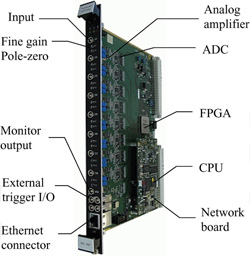HOME > News & Information

Development of Digital Signal Processing Equipment for Practical Application of Multiple Molecular Imaging Devices
Tomonori Fukuchi
Multiple Molecular Imaging Research Laboratory
The Positron Emission Tomography (PET) method, a type of molecular imaging technology, takes an image of position and mass by administering a molecule, in which a positron emitting radionuclide is labeled, into the body, and then detects annihilation gamma-rays resulting from the collision of positrons and electrons. the PET imaging has widely been used for cancer screening tests as a noninvasive clinical examination method with less burden to the body. However, in principle, PET can detect only one type of radionuclide per measurement, so multiple molecules cannot tracked at the same time.
Our research team for the imaging of multiple molecules has developed Gamma-Ray Emission Imaging (GREI) as a next-generation molecular imaging method to supplement PET. The GREI can capture a wider range of gamma-rays than PET, identify different gamma-rays emitted by multiple molecules simultaneously, and visualize their spatial distribution. We are the first in the world to successfully perform simultaneous imaging of multiple molecules using the GREI, and are currently working towards enhanced development aiming for practical application of this device.
The GREI uses germanium semiconductor detectors as the gamma-ray sensor. Although germanium semiconductor detectors can identify and detect gamma-rays with high precision, in order to improve the GREI's characteristics (resolution, sensitivity), it is necessary to analyze the form (wave) of gamma-ray detection signal from semiconductor detector at high speed. At this time, we developed a system which converted the signal wave-form to a digital numerical value in the first phase, and derived the detected energy, time, and position of the gamma-ray by digital numerical processing in order to achieve a specialized wave-form analysis for the GREI. As a result of this, on-line high speed processing of the signal wave-form from the semiconductor detector was realized. Also, this successfully minimized the time lag due to signal processing, as well as making more complicated wave-form analysis possible, compared to the conventional analog based devices. Moreover, this signal processing device can be widely applied, from the specialized wave-form analysis for the GREI to other applications by its extensible design, namely linking this module and other Field-programmable gate array (FPGA) module.

Furthermore, although most signal processing devices for radiation detectors used in Japan have relied on overseas technology, we jointly developed this digital signal processing device with Techno AP, Co., Ltd., a domestic company. Development of Japanese released GREI is expected to accelerate in future.
This research achievement has been published in "IEEE Transactions on Nuclear Science" (Volume 58, Issue 2, Pages 461 – 467).


